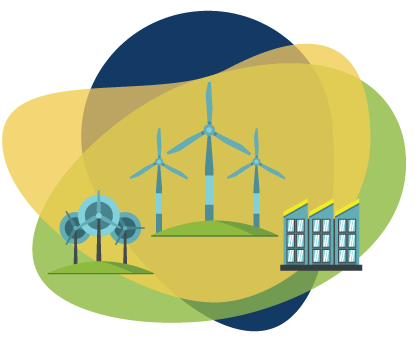
Distributed Energy
Distributed Energy Generation includes sources such as solar, solar gardens, wind turbines, combined heat and power. They are used to provide an alternative or enhancement to traditional electrical power systems. For example many households generate their own electricity via rooftop solar panels, which can then be stored using home battery systems. These separate elements work together to form distributed generation.
The PUC Role
The Commission is tasked with ensuring a safe, fair, and reasonable interconnection process between the customer and the utility. See Statutes & Rules below.
Learn More
Minnesota and Federal law allows customers to install distributed generation (DG) [1] or Distributed Energy Resources (DER) [2] and use the electricity generated or stored to offset the electricity they would otherwise purchase from their electric utility, including cooperatives and municipal utilities. Distributed generation or Distributed Energy Resources (e.x. solar, wind, combined heat and power) are connected to a utility’s electric distribution system. As of December 31, 2023, there were 24,310 distributed energy resources systems totaling nearly 1.54 AC GW of nameplate capacity reported in Minnesota. In addition, some utility customers also have an option to participate in a community solar garden.
[Footnotes 1 and 2] There are a lot of terms used to describe customer-owned distributed generation or distributed energy resources. Some terms carry different meanings, and others reflect changes over time. The federal Public Utilities Regulatory Act (PURPA) refers to “small power producers”, “cogeneration”, and “qualifying facilities” (QF). Some examples of these are rooftop solar, solar + storage, combined heat and power, and distributed wind. Minnesota statute on interconnection references “distributed generation” (DG); whereas, the net metering statute uses similar terms to PURPA. “Distributed Energy Resources” is the emerging terminology used to capture supply and demand side resources that can be used throughout an electric distribution system to meet energy and reliability needs of customers; can be installed on either the customer or utility side of the electric meter; including, distributed generation and storage.
Interconnections
Minnesota law regulates statewide standards for the interconnection of distributed generation/distributed energy resources 10 MW and under which interconnect to the electric grid at the distribution level.
Statutes & Rules
Contracts and Terms
Interconnection Process and Agreements
The customer will be asked to sign a contract that outlines terms and conditions, rates and fees associated with the interconnection of their Distributed Energy Resource. This may be either the Uniform Statewide Contract or the Minnesota Interconnection Agreement. There are some types of Distributed Energy Resources which do not operate in parallel, and may have different requirements.
Tariffs and Rate Schedules
A Tariff refers to the terms and conditions that apply to your services, ie. rates, rules and regulations. These tariffs include compensation rates for distributed generation production (electricity and, in some cases, capacity) delivered to the utility that are updated annually. Public utilities file their annual tariff updates through the Commission’s eDocket system.
Net Metering and Compensation
Generally, if a customer produces more electricity than it uses, a utility will compensate or credit the customer for their excess generation depending on the option the customer elects to receive in the contract they signed with the utility.
Disputes
The Minnesota Public Utilities Commission has a Consumer Affairs Office to answer inquiries and assist customers and utilities in addressing informal complaints through correspondence, mediation, or arbitration.
Related Statutes
-
Minn. Stat. 216B.1611: Interconnection of On-Site Distributed Generation. Requires the establishment of statewide interconnection procedures, the process by which Distributed Generation is connected to the electrical grid.
-
September 28, 2004 Order: Minnesota’s Statewide Interconnection Process and Technical Requirements. Describes Minnesota’s current interconnection procedures for distributed energy resource. These procedures are in the process of being updated in Docket No. 16-521.
-
Minn. Stat. 216B.164: Cogeneration and Small Power Production. State law governing matters related to qualifying facilities (QF) distributed generation, including Net Metering, the Value of Solar, and dispute resolution.
-
Minn. Rules 7835: Cogeneration and Small Power Production Rules. Commission rules implementing Minn. Stat. 216B.164. Note: Some municipal and cooperative utilities have elected to assume Commission jurisdiction as allowed by state law, which means they have adopted their own rules addressing Minn. Stat. 216B.164.
A list of Cooperatives who have passed a resolution and rules assuming authority for distributed generation (Minn. Stat. 216B.164) is available in Docket No. Year “17” – Number “487”. Customers of these cooperatives should refer to their local cooperative for relevant rules.
|
PURPA Cogeneration QF (No Limit) |
||||||
|
PURPA Small Power Production QF (80 MW)
|
|
|||||
|
Termination of Obligation to Purchase from QF (5 MW)
|
|
|||||
|
Minnesota Standard Interconnection Process (10 MW)
|
|
|||||
|
Standard Offer Rate (1 MW) |
QF negotiates contract with utility based on avoided cost
|
|
||||
|
Simultaneous Purchase & Sales or Time of Use Rates (1 MW) |
|
|||||
|
Standard Offer Rate (100kW) |
QF negotiates contract with utility based on avoided cost (5 MW) |
|
||||
|
Simultaneous Purchase & Sale Rate |
Time of Use Rate |
|
||||
|
|
kWh Banking Credit (<40kW - < 1 MW)
|
|
||||
|
kWh Banking Credit (<40kW)
|
|
|||||
|
Net Metering (<40 kW) |
|
|||||
*Bars on this graph are not proportional in size. Please refer to size limits in each bar. In 2017, Minn. Stat. 216B.164 was amended to allow cooperative utilities to assume jurisdiction. Check your local cooperative’s rules which may differ from the state rules used in this chart.
Disclaimer
This webpage is intended as an informational-only, general overview of some key Minnesota statutes, rules and Commission Orders related to customer-sited distributed generation. The information on this page does not represent a Commission interpretation of said statutes, rules and orders.
